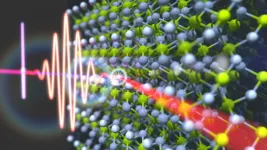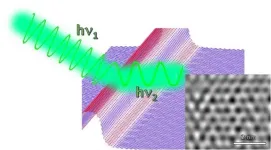(Press-News.org) Drilling a 270,000-year old core from a Tasmanian lake has provided the first Australian record of a major global event where the Earth's magnetic field 'switched '- and the opportunity to establish a precedent for developing new paleomagnetic dating tools for Australian archaeology and paleosciences.
"This is the first study of this kind in Australia since pioneering studies in the 1980s," said author Dr Agathe Lisé-Provonost, a McKenzie Fellow from the School of Earth Sciences at the University of Melbourne.
"Just two lakes in north-east Australia previously provided such "full-vector" record, where both the past directions and the past intensity of the Earth magnetic field are obtained from the same cores."
Published in the journal Quaternary Geochronology, Chronostratigraphy of a 270-ka sediment record from Lake Selina, Tasmania: Combining radiometric, geomagnetic and climatic dating, details how drilling into the 5.5 metre long Lake Selina core established that 41,000 years ago, people in Tasmania must have seen spectacular auroras when the Earth's magnetic field flipped, and for a few thousand years, north was south and south was north.
"During the geomagnetic 'excursion', the strength of the Earth's magnetic field almost vanished," said DrLisé-Provonost.
"This would lead to a big increase in cosmic and solar particles bombarding our planet because the magnetic field normally acts like a shield.
"We don't know when the next geomagnetic excursion will happen, but if one was to occur today, satellites would be rendered useless, smartphone navigation apps would fail, and there would be major disruptions of power distribution systems."
Research leading to that discovery got underway in 2014 when the author travelled to a small sub-alpine lake in western Tasmania with a team led by Associate Professor Michael-Shawn Fletcher, where a makeshift floating platform rigged to two inflatable rafts was used to drill down into the sediment.
With the core containing a climate, vegetation, and paleomagnetic record of the area, the team looked to first accurately date its layers finding evidence of the ecosystem changes that occurred as Tasmanian Aboriginals arrived 43,000 years ago and managed the land over thousands of years. Abrupt changes that occurred since the arrival of Europeans 200 years ago are also evidenced.
"Magnetic particles are eroded from rocks, making their way to a lake by wind or water, and settle down on the lake bottom," said Dr Lisé-Provonost.
"The magnetic particles act like tiny compass needles, aligning with the Earth's magnetic field. As these particles accumulate and become buried, they become locked in place, leaving a history of the Earth's magnetic field. The deeper we drill, the further back in time we go."
It's hoped the research will lead the way for more studies of the past geomagnetic field behavior from Australian lakes and other geological materials such as lava flows, cave deposits and fired archaeological artefacts, for developing new paleomagnetic dating tools and improving models of the Earth's magnetic field to, one day, maybe predict the next geomagnetic excursion.
The research team will now go even further back in time recovering the climate history of Tasmania, with analysing sediments from the 816,000 year-old meteorite impact at Darwin Crater.
INFORMATION:
Milan, 15 February 2021 - Excitons are quasiparticles which can transport energy through solid substances. This makes them important for the development of future materials and devices - but more research is needed to understand their fundamental behaviour and how to manipulate it. Researchers at Politecnico di Milano in collaboration with the Institute of Photonics and Nanotechnologies IFN-CNR and a theory group from the Tsukuba University (Japan) and the Max Plank Institute for the Structure and Dynamics of matter (Hamburg, Germany), have discovered that an exciton can simultaneously adopt two radically different characters when it isstimulated ...
The researchers of TPU together with their colleagues from Russian and foreign scientific centers have found a way to estimate the temperature of a chemical reaction activated by pseudo-particles - plasmons. Two organic molecules served as ultra-small sensors or thermometers. According to scientists, the experiments are of great fundamental importance: beyond the mere fact of evaluating the temperature with the use of molecules, it was possible to demonstrate that properties of plasmon serving as an activator of chemical reactions depend not only on thermal ...
Certain plasma microRNAs could serve as diagnostic biomarkers in mild traumatic brain injury, a new study from the University of Eastern Finland shows. The biomarkers were discovered in an animal model and they were successfully used also to diagnose mild traumatic brain injury in a subgroup of patients. The study was published in the International Journal of Molecular Sciences.
Mild traumatic brain injury is difficult to detect by contemporary conventional imaging methods. In fact, most patients do not exhibit visible structural damage to the brain, which could ...
The tiniest microchips yet can be made from graphene and other 2D-materials, using a form of 'nano-origami', physicists at the University of Sussex have found.
This is the first time any researchers have done this, and it is covered in a paper published in the ACS Nano journal.
By creating kinks in the structure of graphene, researchers at the University of Sussex have made the nanomaterial behave like a transistor, and have shown that when a strip of graphene is crinkled in this way, it can behave like a microchip, which is around 100 times smaller than conventional microchips.
Prof ...
A cloud simulation that captures the development and evolution of clouds based on atmospheric physical processes is more accurate than other models.
"Our model describes atmospheric conditions and thermodynamic processes as well as the fluid dynamics that govern the motion of air in the atmosphere," says Torsten Hädrich, a KAUST Ph.D. student in the international research team. "This allows us to simulate cloud phenomena more realistically than previous methods."
The model can take known atmospheric information at any time, such as temperature, humidity and wind, and simulate cloud formation, which is used for "nowcasting" of imminent cloud phenomena.
"For example, our model is able to simulate the formation of cumulonimbus clouds by considering ...
Scientists at Cardiff University have discovered a unique way to target a common virus that affects one in 200 newborn babies in the UK but for which there is only limited treatments available.
Human cytomegalovirus (HCMV) is a master at "hiding" from the body's immune system so antibodies and T-cells cannot attack it as they do in other viruses, like the current coronavirus.
The researchers have now discovered a new type of antibody in the lab which - instead of killing the virus directly - marks infected cells so the immune system can "see" them.
Once the immune system can see the infected cells it is able to kill the virus.
The team have submitted a patent for the unique immunotherapeutic and hope it can help to treat HCMV, which can leave newborn babies severely disabled or ...
It does not happen often. But on rare occasions, physicians make mistakes and may make a wrong diagnosis. Patients may have many diseases all at once, where it can be difficult to distinguish the symptoms of one illness from the other, or there may be a lack of symptoms.
Errors in diagnosis may lead to incorrect treatment or a lack of treatment. Therefore, everyone in the healthcare system tries to minimise errors as much as possible.
Now, researchers at the University of Copenhagen have developed an algorithm that can help with just that.
'Our new algorithm can find the patients who have such an unusual disease trajectory that they may indeed not suffer from the disease ...
Scientists have discovered that pollution concentration varies between seasons. A new study, conducted in the North China Plain, determined where volatile organic compounds (VOCs) are distributed within the vertical layers of the atmosphere, and found notable changes from winter to summer.
"The concentration of VOCs in the vertical direction was much higher in winter than that in summer and their emission sources showed different contributions in both seasons," said Guiqian Tang, associate professor in the Institute of Atmospheric Physics, Chinese Academy of Sciences, and the corresponding author of a study just published in Advances in Atmospheric Sciences .
The researchers conducted a field campaign from June 8 to July 3, 2019. They focused ...
Researchers have used the zebrafish (Danio rerio) to identify the role of a gene involved in cardiac rhythm, which could help explain the fundamentals of what it takes to make a human heartbeat.
The University of Melbourne study also found that mutation of the gene, Tmem161b, causes potentially fatal cardiac arrhythmia. 2.5 per cent of Australians are living with cardiac arrhythmia ( END ...
Almost half of people testing positive for coronavirus have reported symptoms of depression, according to a new study published in the International Journal of Environmental Research and Public Health.
Researchers from Bangladesh, the United States and Anglia Ruskin University (ARU) in the UK carried out a cross-sectional survey of more than 1,000 Bangladeshi adult coronavirus patients over the course of one month.
A total of 48% of respondents were categorised as having moderate to severe depression, with a higher prevalence in those with persistent symptoms, low family income ...



